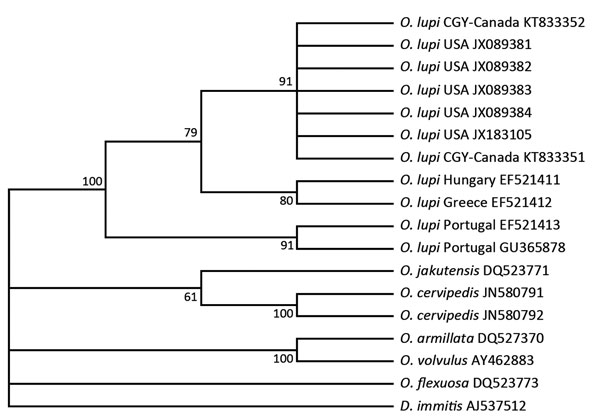Onchocerca lupi Nematodes in Dogs Exported from the United States into Canada
Guilherme G. Verocai
1
, Gary Conboy, Manigandan Lejeune, Fany Marron, Paul Hanna, Erin MacDonald, Brian Skorobohach, Brian Wilcock, Susan J. Kutz, and John S. Gilleard
Author affiliations: University of South Florida, Tampa, Florida, USA (G.G. Verocai); University of Calgary, Calgary, Alberta, Canada (G.G. Verocai, B. Skoroboach, S.J. Kutz, J.S. Gilleard); Atlantic Veterinary College, Charlottetown, Prince Edward Island, Canada (G. Conboy, F. Marron, P. Hanna); Canadian Wildlife Health Cooperative, Calgary (M. Lejeune, S.J. Kutz); Summerside Animal Hospital, Summerside, Prince Edward Island, Canada (E. MacDonald); Calgary Animal Referral and Emergency Centre, Calgary (B. Skoroboach); Histovet, Guelph, Ontario, Canada (B. Wilcock)
Main Article
Figure 2

Figure 2. Phylogenetic relationship among the Onchocerca lupi nematode isolates from a dog in Calgary, Alberta, Canada (GeneBank accession nos. KT833351 and KT833352), and other filarial nematodes in the family Onchocercidae on the basis of the mitochondrial NADH dehydrogenase subunit 5 gene. The parsimonious tree depicts reciprocal monophyly of gene sequence derived from O. lupi nematodes from North America and Europe. Bootstrap consensus was inferred from 1,000 replicates. Values along branches are bootstrap values. Branches corresponding to <50% bootstrap replicates are collapsed. GenBank accession numbers are shown for all isolates. Analysis was performed by using MEGA 6 (http://www.megasoftware.net/). Canine heartworm (Dirofilaria immitis) was used as an outgroup.
Main Article
Page created: July 15, 2016
Page updated: July 15, 2016
Page reviewed: July 15, 2016
The conclusions, findings, and opinions expressed by authors contributing to this journal do not necessarily reflect the official position of the U.S. Department of Health and Human Services, the Public Health Service, the Centers for Disease Control and Prevention, or the authors' affiliated institutions. Use of trade names is for identification only and does not imply endorsement by any of the groups named above.
